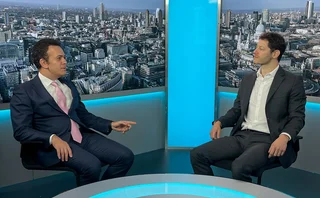
Was Archegos default a one-in-a-million event?
BoE quant says neglecting high leverage and WWR may create conditions for similar blow-ups
At a workshop last year on the collapse of Archegos Capital Management, participants discussed the risks dealers run when they are exposed to highly leveraged clients. The default of the family office in 2021 resulted in a $5.5 billion loss to Credit Suisse, as well as smaller but still sizeable losses to other dealers.
The aim of the workshop was to go over the lessons learned since the collapse, and one of the questions posed was whether the default was a one-in-a-million event. To a quant, the answer to such a question cannot be arrived at through guesswork, nor can it simply be a matter of opinion.
Fabrizio Anfuso, a senior technical specialist at the Bank of England’s Prudential Regulation Authority who works with traded risk models, understood that only a comprehensive analytical approach could provide a satisfactory answer. And that answer was a resounding “no”.
Such events, he argues, only look extremely rare because the tools used to estimate the risk of default by a collateralised leveraged client are potentially inadequate. He argues that defaults on the scale of Archegos are more likely than is commonly perceived. “When there is wrong-way risk and significant leverage, the exposure is actually high even when initial margin is regularly posted,” he says.
It takes two elements to trigger an event such as the huge losses Credit Suisse posted as the result of a client’s collapse. One is a governance failure within the dealer, the frequency and probability of which can be debated. The other is, obviously, a leveraged counterparty defaulting with losses of the magnitude seen in the case of Archegos.
This year’s model
Anfuso has designed a model that, he says, shows how a client could theoretically produce losses three or four times higher than the IM with an ordinary level of leverage – a level lower than that of Archegos. Credit Suisse’s final loss from that particular default was approximately five times the IM. Standard methods, Anfuso argues, ignore the elements that triggered Archegos’s collapse.
“The exposure according to Basel III’s approach, either derived by using internal models or by SA-CCR, in presence of IM might look vanishingly small, because it doesn’t take WWR and high leverage into account,” Anfuso says. “Given the significant impact WWR can have on the assessment of credit exposure, it cannot be neglected and the difficulty of estimating it cannot justify neglecting it or setting it to zero.”
When there is wrong-way risk and significant leverage, the exposure is actually high even when initial margin is regularly posted
Fabrizio Anfuso, Prudential Regulation Authority
His model comprises a system of differential equations that simultaneously capture the underlying’s dynamics, the variation and initial margins, and the counterparty’s balance sheet. “I need the latter because if a counterparty needs to post collateral, this is necessarily taken from its available equity capital and the balance sheet gives information on its solvency,” he says. “My intention is to include all relevant factors in the framework.”
The presence of a collateral agreement is key in this context, because the cases covered by Anfuso’s approach concern defaults driven by a counterparty’s inability to meet a margin call. “From the operational viewpoint, an interesting feature my model offers is the explicit reference to the factors that are determining the exposure: leverage, concentration and WWR correlations.”
The leverage is an explicit variable, which Anfuso measures as the ratio between maximum loss and net asset value – a metric similar to what fund managers typically look at. Tolerance to leverage may vary, but his model shows that with leverage of 30–40%, even when the counterparty has posted IM regularly the actual exposure can be high. By contrast, the Basel III approach, which ignores leverage, is likely to indicate that the exposure is almost zero.
With Anfuso’s model, concentration is implicitly considered and is observable through the effect that a gap, or hike, in the price of an individual underlying has on the portfolio. A well-diversified portfolio, with low concentration, will be less impacted by gaps in its underlyings.
WWR – the coupling between the dynamics of the balance sheet and those of the portfolio’s underlyings – is split between a correlation term modelling the diffusion part and one modelling the gap moves.
Events in the real world have shown why that theoretical distinction matters. Archegos owned significant proportions of the shares in various tech companies, and had all of its assets invested in those businesses. Against this backdrop, it is easy to see how a margin call triggered by a gap in the price of a single tech stock would necessitate the liquidation of others. Selling those stocks would cause the companies’ share prices to crash, thus highlighting a gap correlation between Archegos’s balance sheet and its underlyings.
Typically, banks model a correlated diffusion of market factors and counterparty credit spreads to establish a link between market variables and default risk. That might not include the WWR emerging from the situations described in Anfuso’s work, in which the counterparty’s portfolio is correlated with the collateral it is required to post.
“The type of WWR Anfuso’s paper deals with is quite specific,” says Matthias Arnsdorf, global head of XVA and counterparty risk quantitative research at JP Morgan. “It probably has a bigger effect in these particular instances and it’s not been considered much in exposure calculations so far.”
At the time of the Archegos default, Anfuso was part of Credit Suisse’s Ibor transition team, and was not involved in the operations that led to the bank’s losses. However, he had already spent most of his career as a credit quant, a role he has returned to since joining the UK’s central bank.
Mind the gaps
Other quants have also worked on improving the calculation of exposure to leveraged counterparties. In 2022, Andrew Dickinson proposed a model based on jump processes that links market gaps and counterparty defaults.
“Differently from Dickinson’s approach, I’m not attempting to devise a new stochastic process for the risk factors at play,” says Anfuso. “I take a stochastic process for the underlying, which is a simple Merton model with diffusion term and jumps, and I focus on tracking all the components – and their correlations, including jumps correlations – that drive the credit and market risks entering the exposure assessment.”
Later in 2022, Michael Pykhtin, a manager in the US Federal Reserve Board’s policy research and analytics team, proposed a model designed to overcome the SA-CCR’s flaws, but without focusing on the effects of leverage or WWR.
Arnsdorf is researching an alternative model to those presented by Anfuso, Pykhtin and Dickinson. “I view Anfuso’s work as a bottom-up approach to counterparty exposure,” he says. “What I’m looking at is a top-down one which doesn’t need explicit information on the counterparty’s balance sheet, but [one in which] we can make high-level assumptions about how much collateral the counterparty can post before defaulting.” This could provide a model that accounted for WWR, that would be easy to implement and that would have only a few, easy-to-calibrate parameters.
Anfuso says the current version of his own model is sufficient to analyse the Archegos case. However, he adds that the natural extension will be to enable it to deal with more complex portfolios that include different underlyings and non-linearities. This is what he is working on now.
Editing by Daniel Blackburn
Only users who have a paid subscription or are part of a corporate subscription are able to print or copy content.
To access these options, along with all other subscription benefits, please contact info@risk.net or view our subscription options here: http://subscriptions.risk.net/subscribe
You are currently unable to print this content. Please contact info@risk.net to find out more.
You are currently unable to copy this content. Please contact info@risk.net to find out more.
Copyright Infopro Digital Limited. All rights reserved.
As outlined in our terms and conditions, https://www.infopro-digital.com/terms-and-conditions/subscriptions/ (point 2.4), printing is limited to a single copy.
If you would like to purchase additional rights please email info@risk.net
Copyright Infopro Digital Limited. All rights reserved.
You may share this content using our article tools. As outlined in our terms and conditions, https://www.infopro-digital.com/terms-and-conditions/subscriptions/ (clause 2.4), an Authorised User may only make one copy of the materials for their own personal use. You must also comply with the restrictions in clause 2.5.
If you would like to purchase additional rights please email info@risk.net
More on Views
UBS’s Iabichino holds a mirror to bank funding risks
Framing funding management as an optimal control problem affords an alternative to proxy hedging
Podcast: Alexei Kondratyev on quantum computing
Imperial College London professor updates expectations for future tech
Quants mine gold for new market-making model
Novel approach to modelling cointegrated assets could be applied to FX and potentially even corporate bond pricing
Quants dive into FX fixing windows debate
Longer fixing windows may benefit clients, but predicting how dealers will respond is tough
Podcast: Piterbarg and Nowaczyk on running better backtests
Quants discuss new way to extract independent samples from correlated datasets
BofA quants propose new model for when to hold, when to sell
Closed-form formula helps market-makers optimise exit strategies
Podcast: Alvaro Cartea on collusion within trading algos
Oxford-Man Institute director worries ML-based trading could have anti-competitive effects
Podcast: Lorenzo Ravagli on why the skew is for the many
JP Morgan quant proposes a unified framework for trading the volatility skew premium








